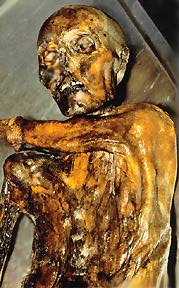Controversial theories of human origins,
mixed with a measure of coincidence,
and sprinkled with prose and fantasy.
Lessons of the Tyrolean Iceman
 Turns out we can learn a lot from Frozen Fritz. Also called Oetzi, the iceman recovered from the Austrian alps in 1991 and has been carbon dated to 3300 b.c.e. Turns out he lived at the time of the Copper age in Europe. It is entirely possible that he is a representative of the Ozieri culture that later developed huge megalithic walls for defense against the very agressive Nuragic culture that began to take over the area in about 1600 b.c.e. His body was found 92.56 meters inside Italian territory (46°46’44?N 10°50’23?E? / ?46.77889, 10.83972).
Turns out we can learn a lot from Frozen Fritz. Also called Oetzi, the iceman recovered from the Austrian alps in 1991 and has been carbon dated to 3300 b.c.e. Turns out he lived at the time of the Copper age in Europe. It is entirely possible that he is a representative of the Ozieri culture that later developed huge megalithic walls for defense against the very agressive Nuragic culture that began to take over the area in about 1600 b.c.e. His body was found 92.56 meters inside Italian territory (46°46’44?N 10°50’23?E? / ?46.77889, 10.83972).
The Ozieri carved underground structures out of the solid rock called in their legends “domus de janas” or Houses of the Fairies. These are considered graves but have long ago been looted, so there is no real evidence left of them being used otherwise. They lived as farmers and artisans, producing fine pottery, metal implements, obsidian, huge dolmen and megalithic circles such as that found in Stonehenge and Avebury. They had trade with areas all over the Mediterranean region.
They had a simple religion based on gods I recognize from other cultures all around the world: the Horned Bull and the Mother Godess.
What do we learn from him?
Continue reading: Lessons of the Tyrolean Iceman
Of Gods and Mortals

Is it possible that our definition of God has changed over the last 10,000 years?
Could it be that the original meaning of the word God was “a master more powerful/intelligient than anyone else we have encountered”? or even “the strong guy that wields lightning and orders us around a lot”? and that through centuries of encounters with god and storytelling about these experiences we have embellished to the point of deification? It would explain a lot…
Continue reading: Of Gods and Mortals
The Piri Reis Map
In 1929, scholars working in the archives of the Ottoman Empire in Turkey’s Topkapi Palace Museum made an exciting discovery: a section of an early 16th-century Ottoman map based in part, apparently, on the original chart drawn or used by Christopher Columbus and showing his historic discoveries in the New World. The map, signed by an Ottoman captain named Piri Reis, was dated 1513, just 21 years after Columbus discovered America.
A Turkish friend of mine was kind enough to locate and obtain an official Turkish Navy copy of the Piri Reis map as it is displayed in the museum in Istanbul…with one key difference. The Arabic comments in the margins have been replaced by English translated comments.
Continue reading: The Piri Reis Map
 Entries and comments feeds.
Valid XHTML and CSS. ^Top^
Entries and comments feeds.
Valid XHTML and CSS. ^Top^
72 queries. 0.835 seconds.
Powered by WordPress design by John Doe.